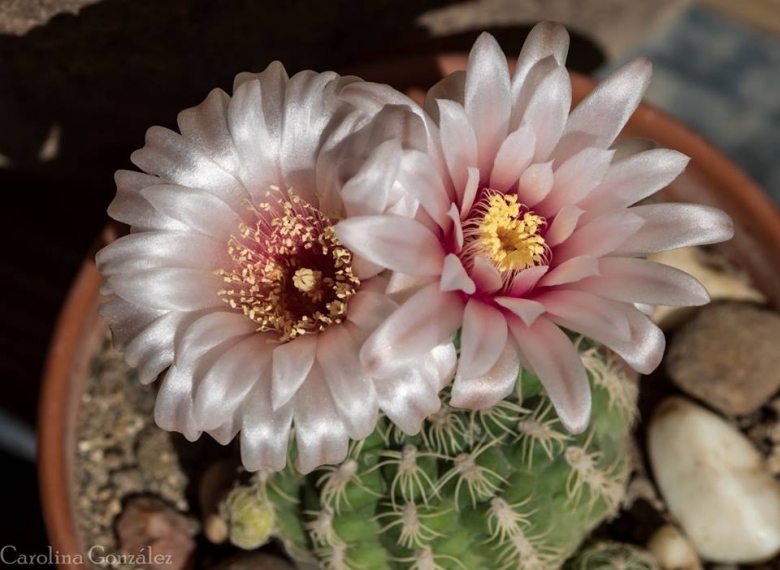
Gymnocalycium calochlorum Photo by: Carolina González
Origin and Habitat: Gymnocalycium calochlorumSN|16401]]SN|16401]] is endemic to Argentina, where it occurs in Córdoba. It is very widespread and locally abundant.
Altitude range: (500-)800 to 1,500 metres above sea level.
Habitat and Ecology: This species is often buried in crumbling granite, where it can be difficult to find if not in flower or fruit. It grows in high-altitude grasslands and chaco forest. The species is tolerant to disturbance. There are no known major threats to this species.
Synonyms:
See all synonyms of Gymnocalycium calochlorum
back
Accepted name in llifle Database:Gymnocalycium calochlorum (Boed.) Y.ItôCacti (Borg) 1952, 90. as Gymoncalycium ; cf. Gray Herb. Card Cat.Synonymy: 8
back
Common Names include:
ENGLISH: Clustering chin cactus
RUSSIAN (Русский): Гимнокалициум зелёный
Description: Gymnocalycium calochlorumSN|16401]]SN|16401]] (clustering chin cactus) is a small flattened cactus forming low, flat-topped clusters of many stems that grow level to soil. The spines are wispy and mostly pinkish brown. The light pink flowers are trumpet shaped over 5 cm across at the widest point. They does not open completely.
Stem: Solitary to very clumped in habitat, depressed-spherical, about 6 cm wide and 4 cm high, shining pale green, grey-green or blue-green,
Ribs: Broad, flat and tuberculate 8 to 12 (but generally 11), the tubercles are polygonal +/- rounded divided by short transversal grooves .
Areoles: Oval, covered with a yellowish tomentum that tends to whiten as they age.
Radial spines: 9-13, thin, flexible, slender, rough of different length, 5-10 mm long, curved sideways and downwards, very close to each other and often interlacing. They are white to pinkish brown, sometime with a reddish basal portion at first, later greyish white.
Central spines: Absent.
Flowers: Usually solitary, born near apex, trumpet-shaped, not opening as widely as most chin cactus flowers, pale pink, about 5-6 cm long and 5-6(-7.5) cm in diameter, throat rose-carmine. Flower tube is robust about 1 cm in diameter, dark shining leaf-green, with rounded, mucronate, white scales 4 mm wide. Outer perianth segments pink with grey-green tip.
Fruits: Ovoidal to clavate 1,2-3,5 cm long more or less elonged, epidermis is greenish with a grey-bluish pruine coat. It is covered by small rounded scales bordered with white and contains a large quantity of seeds with the length of 1 mm.
Subspecies, varieties, forms and cultivars of plants belonging to the Gymnocalycium calochlorum group
 Gymnocalycium calochlorum (Boed.) Y.Itô: It is very flat growing species that clusters readily to form nice clumps. The spines are white thin, curved inward and very close to each other.
Gymnocalycium calochlorum (Boed.) Y.Itô: It is very flat growing species that clusters readily to form nice clumps. The spines are white thin, curved inward and very close to each other.- Gymnocalycium calochlorum var. proliferum (Backeb.) Backeb.: has a little bigger darker green stem with flowers that open completely, showing curved petals to the outside white, brownish white, or pink coloured.
- Gymnocalycium calochlorum var. roseiacanthum hort.: has smaller stems about 3 cm. wide and 2 cm. high, yellowish areoles with twisted pink spines and big white flowers with a pink base.
Bibliography: Major references and further lectures
1) Edward Anderson “The Cactus family” Timber Press, Incorporated, 2001
2) David R Hunt; Nigel P Taylor; Graham Charles; International Cactaceae Systematics Group. "The New Cactus Lexicon" dh books, 2006
3) James Cullen, Sabina G. Knees, H. Suzanne Cubey "The European Garden Flora Flowering Plants: A Manual for the Identification of Plants Cultivated in Europe, Both Out-of-Doors and Under Glass" Cambridge University Press, 11/Aug/2011
4) Pilbeam, John. “Gymnocalycium: A Collector's Guide.” A. A. BALKEMA / ROTTERDAM / BROOKFIELD / 1995
5) Demaio, P. & Trevisson, M. 2013. Gymnocalycium calochlorum. The IUCN Red List of Threatened Species 2013: e.T151908A575079. http://dx.doi.org/10.2305/IUCN.UK.2013-1.RLTS.T151908A575079.en. Downloaded on 12 February 2016.
6) Leo J. Chance “Cacti and Succulents for Cold Climates: 274 Outstanding Species for Challenging Conditions” Timber Press, 19 June 2012
7) Кунте Л. “Иллюстрированная энциклопедия. Кактусы.”, 2004.
8) Krainz (ed.), “Die Kakteen”, 11 g. 58 1974
9) John Borg “Cacti” 1952
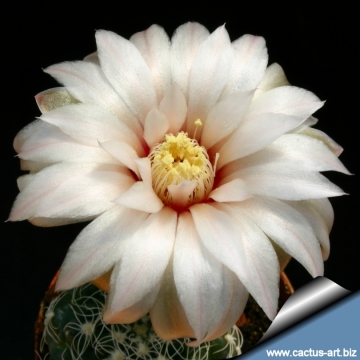 Gymnocalycium calochlorum Photo by: Cactus Art
Gymnocalycium calochlorum Photo by: Cactus Art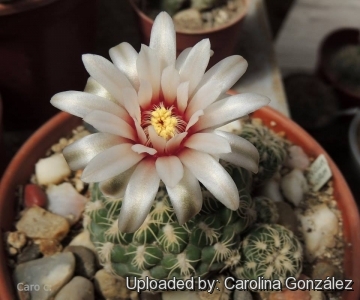 Gymnocalycium calochlorum Photo by: Carolina González
Gymnocalycium calochlorum Photo by: Carolina González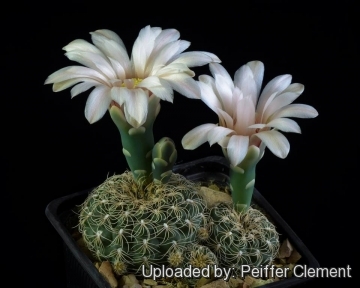 Gymnocalycium calochlorum Photo by: Peiffer Clement
Gymnocalycium calochlorum Photo by: Peiffer Clement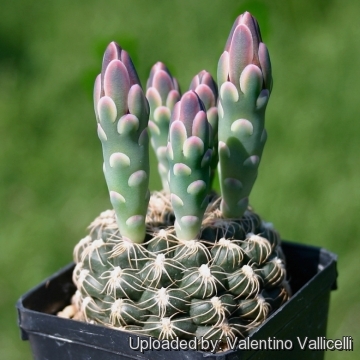 Gymnocalycium calochlorum Photo by: Valentino Vallicelli
Gymnocalycium calochlorum Photo by: Valentino Vallicelli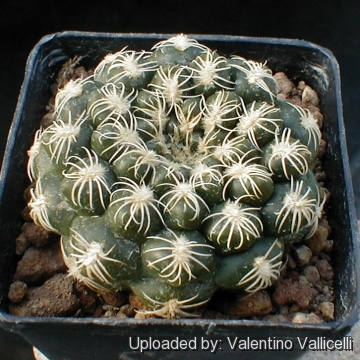 Gymnocalycium calochlorum Photo by: Valentino Vallicelli
Gymnocalycium calochlorum Photo by: Valentino Vallicelli Gymnocalycium calochlorum Photo by: Cactus Art
Gymnocalycium calochlorum Photo by: Cactus Art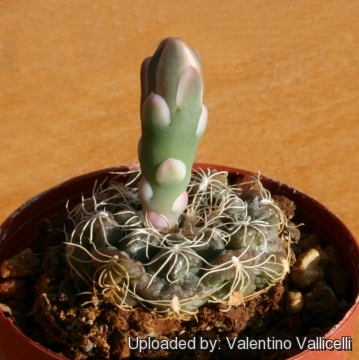 Gymnocalycium calochlorum Photo by: Valentino Vallicelli
Gymnocalycium calochlorum Photo by: Valentino Vallicelli Gymnocalycium calochlorum Photo by: Carolina González
Gymnocalycium calochlorum Photo by: Carolina GonzálezCultivation and Propagation: Gymnocalycium calochlorumSN|16401]]SN|16401]] is a summer grower species that offers no cultivation difficulties.
Watering needs: Water regularly in summer (but do not overwater).
Soil: This species prefer relatively rich, draining and low pH compost (if possible not limestone) otherwise growth will stop altogether.
Repotting: This plant needs plenty of space for its roots, repotting should be done every other year or when the it has outgrown its pot.
Fertilization: Feed with a high potassium fertilizer in summer.
Exposure: The plant tolerate extremely bright situations but enjoy fresh places and some shade during the hottest part of the day in summer.
Hardiness: Keep this plant almost dry in winter at a minimum temperature of -5°C (but it is resistant down to -23 if grown in ground and very dry). Outdoors is not necessary to cover these plants in winter even in cold temperate climates, but doing so it is nor harmful if the cover is removed by early spring. Flower-buds form yearly in the season and plants that are covered in midspring may not bloom.
Pest and diseases: This species is particularly easy and accommodating, seldom suffer of cryptogamic diseases.
Propagation: Seeds or by rooting offsets. Seed Collecting: Permit fruit to ripen. Fruit must be significantly overripe before harvesting seed; clean and dry seeds. Outdoors in the rock garden this species easily seeds itself around.
Your Photos
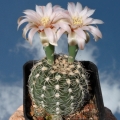
by Valentino Vallicelli

by Carolina González

by Valentino Vallicelli

by Cactus Art
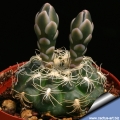
by Cactus Art























